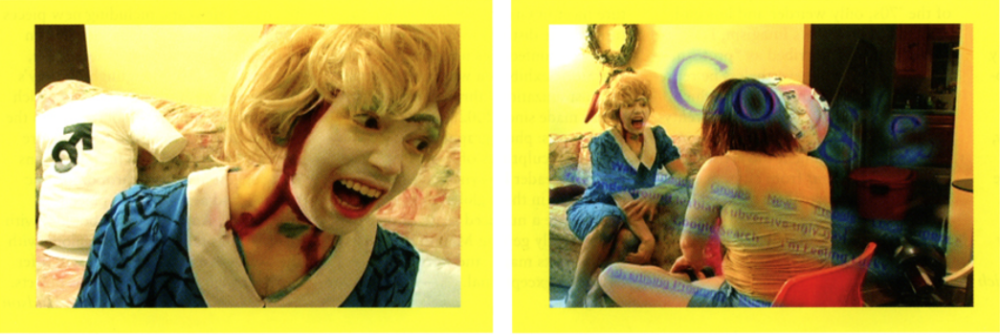
- Source: ARTFORUM
- Author: NICK STILLMAN
- Date: JANUARY 2009
- Format: PRINT
Youth Initiative

Ryan Trecartin, (Tommy Chat Just E-mailed Me.). 2006, stills from a color video. 7 minutes 21 seconds. From left: Tammy (Ryan Trecartin); Tammy (Ryan Trecartin) and Beth (Lizzie Fitch)
OSCAR WILDE QUIPPED LONG AGO that “in America the young are always ready to give to those who are older than themselves the full benefits of their inexperience.” By now, his joke has perhaps worn a little thin, as the young of today roll their eyes at confused baby boomers fumbling hopelessly with “the e-mail.” But it has also been corroborated by the ascendance of youth culture over the course of the past century—and perhaps nowhere more so than in the art world of the past decade, in which dealers competed ferociously to trump one another by debuting the next new thing. Now, however, as a crumbling stock market and a dry well of credit conjure the possibility that galleries and collectors will turn to the safer investments offered by more established artists, the reign of reign of the young, at least in the commercial art world, may well be over.
In the midst of this changing context, the rebuilt, refashioned, and reimaged New Museum in New York is launching a new triennial, whose first edition is titled “The Generational: Younger than Jesus.” Jointly organized by Lauren Cornell, Massimiliano Gioni, and Laura Hoptman, it runs from April 8 through June 28 and features a roster of approximately fifty artists all under the age of thirty-three—that being, of course, the age at which Jesus died. The exhibition feels both awkwardly and appropriately timed. It could be that in an environment of pitched financial worry, museum supershows will remain among the few key sires of exposure for young artists, and one might even optimistically hope that the triennial heralds an age in which financial speculation is replaced by intellectual speculation, and sociopolitical ontologies come to matter more than economic potential. Still, it’s hard not to see the emphasis on youth as reflecting poorly on an atmosphere in which a young artist whose CV isn’t replete with solo exhibitions, inclusion in major international group shows, and a history of reviews is made to feel behind. The first press release for “The Generational”—issued this past June—justified the cutoff point by asserting, “Some of the most enduring, influential, and radical changes in art and history have been carried out by young people.” That is unarguable, even if many artists have actually blossomed only when well into their thirties or older. An acknowledgment of this unspoken reality is perhaps latent in the exhibition’s subtitle, which might be understood as also alluding to artists’ early career crises—a touch of curatorial gallows humor, maybe.
In the same press release, New Museum director Lisa Phillips further elucidated the exhibition’s premise with the claim that “new generations … reveal urgently important things the rest of us cannot yet see, anticipating the future and helping shape what is coming next.” Yet the very concept of a generation appears challenged by the variety of the artists in “The Generational,” who range from the relatively unknown (Mariechen Danz, Ida Ekblad) to more recognized figures, such as typography/symbology-obsessed Tauba Auerbach or notorious YouTube pioneer and Pecker-like gallery sensation Ryan Trecarrin. Does the proximity of the years of their birth really bring together people separated by wildly disparate national, racial, moral, economic, and political situations? Or, put differently, will “The Generational” end up revealing the notion of a generation as too complex an organism to capture in one exhibition?
The curators stress the commonalities that they expect to become evident—among them preoccupations with history, the omnipresence of technology, and the changing construction of families, tribes, and social groups. Indeed, the exhibition’s installation is conceived to match a vision of “Generation Y” as “the first natives of a digital world” by presenting, in Gioni’s words, a “co-existence of individualities” approximating the matrices of social networking websites.
The exhibition’s unorthodox curatorial methodology also reflects this notion of a digitally networked global community. In selecting their international roster of artists, the curators traveled very little themselves, instead engaging the services of ten “correspondents” and approximately 150 curators and critics involved in local scenes around the world, who were asked for recommendations. Special attention was paid to countries traditionally underrepresented in American group shows—Algeria, Armenia, Kazakhstan, and Romania among them. This devolved methodology approximates the philosophy of decentralization that drove Charley—the magazine Gioni coedited with Maurizio Cattelan and Ali Subotnik—which tapped contributors to create single pages for huge issues, as well as the 2007 Lyon Biennale, orchestrated by Stephanie Moisdon and Hans Ulrich Obrist, for which forty-nine critics and curators were asked to participate in a kind of game in which each invited a single artist.
This move toward reliance on networks and secondhand information makes sense, especially as art-world travel diminishes in leaner times. Such a shift seems reflected in the “directory” that (in addition to a catalogue-cum-“reader”) accompanies the show. This tome includes information on the five-hundred-plus artists who were recommended for inclusion, offering—appropriately for an Internet-influenced show—a voyeuristic peek into the losers’ bracket, while implicitly acknowledging the inevitability of a degree of arbitrariness in any survey of a massive art world with such a polyphony of positions. Still, it’ll be fascinating to see the outcome: Will the confluence of exhibition model and networked generation succeed, or will it expose the limits of technology and globalization’s ability to close the gaps of geography and culture?

